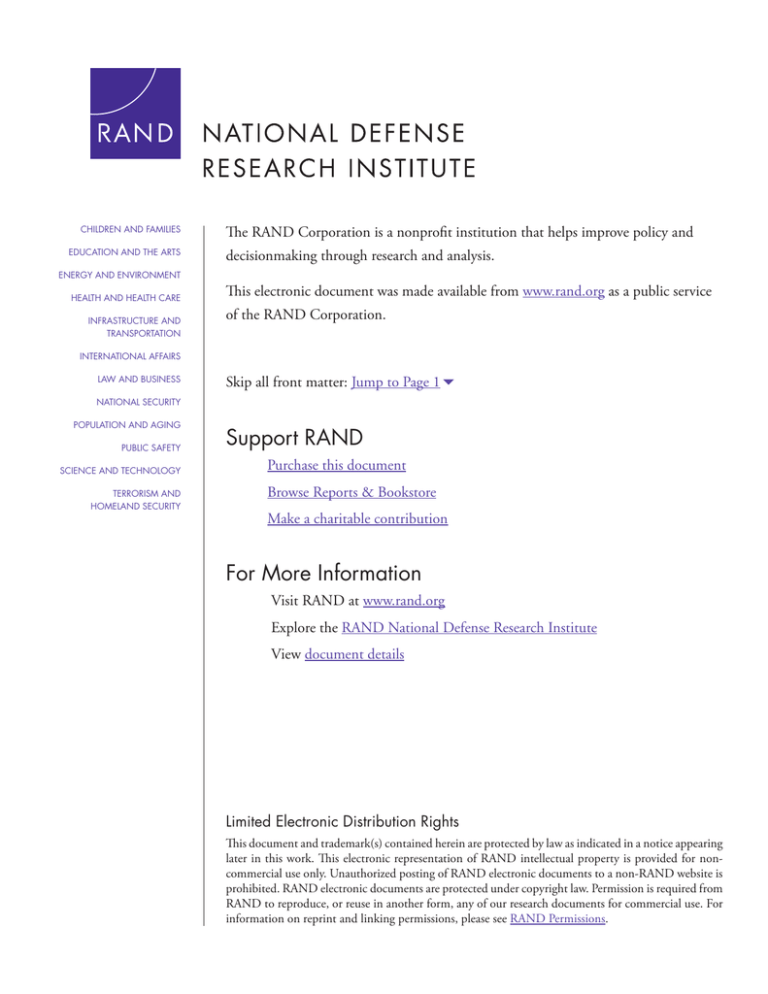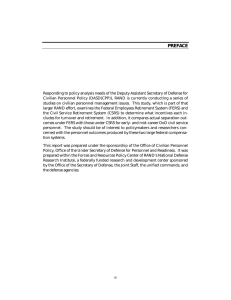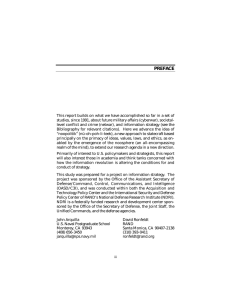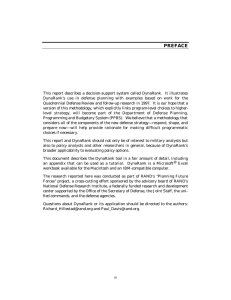The RAND Corporation is a nonprofit institution that helps improve... decisionmaking through research and analysis.
advertisement

CHILDREN AND FAMILIES EDUCATION AND THE ARTS The RAND Corporation is a nonprofit institution that helps improve policy and decisionmaking through research and analysis. ENERGY AND ENVIRONMENT HEALTH AND HEALTH CARE INFRASTRUCTURE AND TRANSPORTATION This electronic document was made available from www.rand.org as a public service of the RAND Corporation. INTERNATIONAL AFFAIRS LAW AND BUSINESS Skip all front matter: Jump to Page 16 NATIONAL SECURITY POPULATION AND AGING PUBLIC SAFETY SCIENCE AND TECHNOLOGY TERRORISM AND HOMELAND SECURITY Support RAND Purchase this document Browse Reports & Bookstore Make a charitable contribution For More Information Visit RAND at www.rand.org Explore the RAND National Defense Research Institute View document details Limited Electronic Distribution Rights This document and trademark(s) contained herein are protected by law as indicated in a notice appearing later in this work. This electronic representation of RAND intellectual property is provided for noncommercial use only. Unauthorized posting of RAND electronic documents to a non-RAND website is prohibited. RAND electronic documents are protected under copyright law. Permission is required from RAND to reproduce, or reuse in another form, any of our research documents for commercial use. For information on reprint and linking permissions, please see RAND Permissions. This product is part of the RAND Corporation technical report series. Reports may include research findings on a specific topic that is limited in scope; present discussions of the methodology employed in research; provide literature reviews, survey instruments, modeling exercises, guidelines for practitioners and research professionals, and supporting documentation; or deliver preliminary findings. All RAND reports undergo rigorous peer review to ensure that they meet high standards for research quality and objectivity. A Methodology for Implementing the Department of Defense’s Current In-Sourcing Policy Jessie Riposo, Irv Blickstein, Stephanie Young, Geoffrey McGovern, Brian McInnis Prepared for the United States Navy Approved for public release; distribution unlimited NATIONAL DEFENSE R ESEA R C H I N ST I T UT E The research described in this report was prepared for the United States Navy. The research was conducted within the RAND National Defense Research Institute, a federally funded research and development center sponsored by the Office of the Secretary of Defense, the Joint Staff, the Unified Combatant Commands, the Navy, the Marine Corps, the defense agencies, and the defense Intelligence Community under Contract W74V8H-06-C-0002. Library of Congress Cataloging-in-Publication Data A methodology for implementing the Department of Defense's current in-sourcing policy / Jessie Riposo ... [et al.]. p. cm. Includes bibliographical references. ISBN 978-0-8330-5311-4 (pbk. : alk. paper) 1. United States. Dept. of Defense—Procurement. 2. United States. Dept. of Defense—Rules and practice. 3. Contracting out—United States—Evaluation. I. Riposo, Jessie. II. Title. UC263.M445 2011 355.6'21—dc23 2011025827 The R AND Corporation is a nonprofit institution that helps improve policy and decisionmaking through research and analysis. RAND’s publications do not necessarily reflect the opinions of its research clients and sponsors. R® is a registered trademark. © Copyright 2011 RAND Corporation Permission is given to duplicate this document for personal use only, as long as it is unaltered and complete. Copies may not be duplicated for commercial purposes. Unauthorized posting of RAND documents to a non-RAND website is prohibited. RAND documents are protected under copyright law. For information on reprint and linking permissions, please visit the RAND permissions page (http://www.rand.org/publications/ permissions.html). Published 2011 by the RAND Corporation 1776 Main Street, P.O. Box 2138, Santa Monica, CA 90407-2138 1200 South Hayes Street, Arlington, VA 22202-5050 4570 Fifth Avenue, Suite 600, Pittsburgh, PA 15213-2665 RAND URL: http://www.rand.org To order RAND documents or to obtain additional information, contact Distribution Services: Telephone: (310) 451-7002; Fax: (310) 451-6915; Email: order@rand.org Summary Identifying the appropriate balance between contractor and government staff is not a new challenge for the government. However, recent direction from Department of Defense (DoD) leadership has led to increased awareness of the importance of finding this balance. In his fiscal year (FY) 2010 budget message, Secretary of Defense Robert M. Gates called for growing the civilian workforce by replacing contractors with DoD civilian personnel.3 In the 2010 Quadrennial Defense Review, DoD’s ongoing in-sourcing efforts were described as a means of establishing “a balanced total workforce . . . that more appropriately aligns public and private sector functions.”4 In August 2010, Secretary Gates called for a halt to the creation of Office of the Secretary of Defense (OSD) positions to replace contractor staff after FY 2010.5 Although some may have believed that in-sourcing efforts were to be ceased, additional guidance clarified that in-sourcing efforts would continue. A three-year hiring freeze was implemented at OSD, the combatant commands, and the defense agencies, but in-sourcing was allowed to continue in the military departments.6 The research conducted by the RAND Corporation reviewed the recent history of outsourcing and in-sourcing and assessed the current laws and policies pertaining to in-sourcing in order to develop a framework and methodology for applying the current laws and policies to arrive at a decision about in-sourcing. This research was initially undertaken as part of an insourcing assessment for a U.S. Navy organization. However, during research, we discovered a gap in the current in-sourcing guidance, and individuals tasked with in-sourcing still appeared to be struggling to interpret and implement this guidance. This report interprets commonly used terms, such as inherently governmental, and describes an approach to implementing current in-sourcing guidance. A History of Government Sourcing Until the mid-1990s, outsourcing predominated at DoD. For decades, the department embraced expanding roles for private contractors as a means of achieving efficiencies and accomplishing missions. Federal policy reflected the belief that government outputs could be improved by letting the private sector perform an increasing array of functions. In the three decades prior to 3 U.S. Department of Defense, 2009. 4 U.S. Department of Defense, 2010a, p. 56. 5 Office of the Assistant Secretary of Defense (Public Affairs), “Sec. Gates Announces Efficiencies Initiatives,” News, Release No. 706-10, August 9, 2010. 6 Robert Brodsky, “Union Blasts Scaled Down Defense In-Sourcing Plan,” September 30, 2010c. ix x A Methodology for Implementing the Department of Defense’s Current In-Sourcing Policy the mid-1990s, laws and policies had been changed to reflect the preference that contractors increasingly perform activities for DoD. This contributed to a decline in the civilian workforce. Between 1989 and 2002, the DoD civilian workforce declined by about 38 percent, dropping from 1,075,437 civilians to 670,166.7 Although there have always been opponents of outsourcing, increased interest in reevaluating the workforce mix began to emerge in early 2000. A Defense Science Board task force reported that the “[r]apid downsizing during the last ten years” had been a catalyst for rethinking the balance between components of the “total force”—contractors, civilian personnel, and military personnel.8 In-sourcing momentum increased with support from members of Congress, and significant in-sourcing initiatives began when the Obama administration took office. However, this renewed focus on in-sourcing required clarification of existing workforce planning guidance and policy and of the in-sourcing process. Unfortunately, producing definitive guidance that can be used to objectively determine the appropriate balance between contractor and government staff has proven quite challenging. Most policy and guidance has reflected the preferences of the presidential administration. Although there are definitions of the criteria to be used to determine whether a function should be performed by a contractor or government civilian, these definitions vary, and the in-sourcing analyst must exercise judgment in interpreting them. Current Policy Law and policy restrict the use of contractors for functions that should be the exclusive or nearexclusive responsibility of government employees. These restrictions identify the nature of work that contractors may not perform or that they may perform only under specific circumstances. There are four major restrictions on the use of contractors: • a prohibition on contractor performance of inherently governmental (IG) functions • special rules about the use of contractors to perform functions closely associated with IG functions • a prohibition on the use of personal-services contracts • DoD-specific exemptions from private-sector performance of specific commercial functions identified in law and policy. As of this writing, there is also a proposed new restriction on contractor performance of critical functions. The underlying concept behind each of these restrictions is straightforward: Only government employees should wield the authority of the government. However, consistent implementation is challenged by the level of interpretation required to assess whether various functions meet these criteria. 7 U.S. General Accounting Office, DoD Personnel: DoD Actions Needed to Strengthen Civilian Human Capital Strategic Planning and Integration with Military Personnel and Sourcing Decisions, Washington, D.C., GAO-03-475, 2003. 8 Defense Science Board Task Force, Human Resources Strategy, Washington, D.C.: Department of Defense, 2000. Summary xi Our Approach We reviewed the history of sourcing as well as current policy and guidance pertaining to insourcing. This material served as the basis for our development of an analytical approach to help government departments implement in-sourcing plans that comply with the most-current policy and the most-current federal restrictions on the use of contractors. Our approach is based on a 2009 Deputy Secretary of Defense memorandum that provides a decision-tree method and a defined set of criteria for in-sourcing (see Figure S.1). However, to apply this approach to a population of contractors, we had to select and interpret definitions of the assessment criteria provided in existing guidance and instructions. In addition, to assess whether defined criteria were met, we had to construct and answer specific questions, such as “How is inherently governmental defined, and what types of questions should be asked in order to determine whether a function is inherently governmental?” Although this exercise may appear to be rather simple at first glance, developing a definition and set of questions that result in consistent assessment is actually quite challenging. The questionnaire we developed for civilian leadership to use in determining whether selected criteria for in-sourcing are met is reproduced in Appendix C. Figure S.1 The In-Sourcing Assessment Process Identity functions for possible in-sourcing Is the mission requirement valid and enduring? Yes No Is the function inherently governmental? No Is the function exempt from private-sector performance? No Is the contract for unauthorized personal services? Yes Yes In-source Yes No Are there problems with contract administration? Yes Retain services in the private sector No Do special considerations yield an in-sourcing solution? SOURCE: Based on Deputy Secretary of Defense, “In-Sourcing Contracted Services—Implementation Guidance,” memorandum, May 28, 2009. RAND TR944-S.1 No






